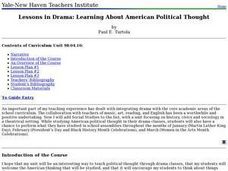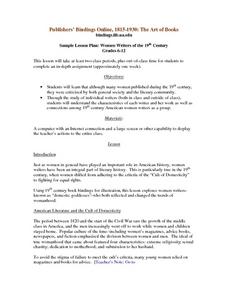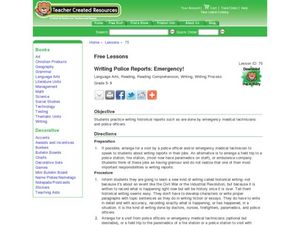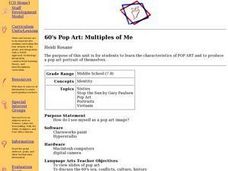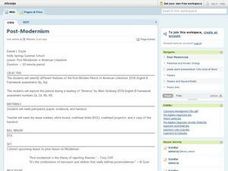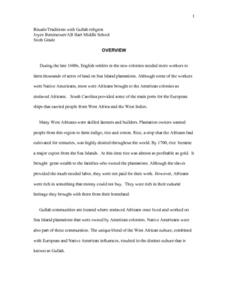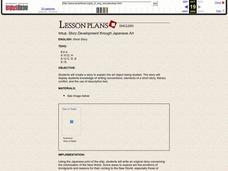Curated OER
Uncle Tom's Cabin
Students read the novel, Uncle Tom's Cabin, and explain public attitudes towards slavery in 19th century America.
Curated OER
Literature Circles
Fourth graders work in groups in order to motivate one another to develop reading comprehension and literacy skills. The skills are built through the sharing of fine literature. They maintain a reading log to keep accountable for the...
Curated OER
The Bill of Rights in Times of National Crisis
Learners examine the ability of the government to suspend individual rights in times of national crisis. They formulate a constitutional amendment that clearly states if, when, how and by whom the rights of individuals can be suspended.
Curated OER
Fugitive from Labor Cases: Henry Garnett (1850) and Moses Honner (1860)
Students engage in the comparison of cases which demonstrate the increasingly volatile political crisis in the 1850s arising over the issue of slavery and the necessity for the enactment of the 13th, 14th, and 15th Amendments to the U.S....
Curated OER
Stowe's Reviewers
Young scholars read, evaluate and respond to both positive and negative reviews of Harriet Beecher Stow's, Uncle Tom's Cabin.
Curated OER
What Does This Song Really Say?
Young scholars investigate communication by analyzing lyrics from a song. In this music arts instructional activity, students discuss slavery, the Underground Railroad and African American traditions while listening to a song called...
Curated OER
Lessons in Drama: Learning About American Political Thought
Students develop critical thinking skills so that they may produce their own written plays or music from their thoughts and feelings. They express their thoughts based on what has been presented to them over the duration of the course.
Curated OER
Organizing Main Ideas and Supporting Details
Learners read given information and identify the main ideas and specific detail of the story. In groups, they read a historical title and create a "book talk" for each one, summarizing the story. In addition, students create a...
Curated OER
Writers of the 19th Century
Students are introduced to women authors during the 19th century. In groups, they read about the criticism they faced during this time period by the public and literary community. Using the internet, they research one author to...
Curated OER
A Colony is Born : Lesson 2 - Sez Who?
Second graders increase their baseline knowledge of primary and secondary sources and the likenesses and differences of them with regard to a selected historical event.
Curated OER
Writing Police Reports: Emergency!
Students practice writing emergency reports. In this emergency reports lesson, students participate in a visit from a police officer or emergency technician. Students then write a historical report based on the fictional account the...
Curated OER
Writing Police Reports
Students discover police procedures by filling out crime reports. In this government lesson, students discuss the benefits of historical reports pertaining to criminals and victims. Students listen to an officer of the law...
Curated OER
Literature for Lesson 4 - Abolitionists
Learners examine the definition of abolition and abolitionists. In this abolition lesson, students complete vocabulary work before reading about Harriet Tubman, Sojourner Truth, and Frederick Douglass. They watch a video about Harriet...
Curated OER
The Battle of the Little Bighorn
Students assess how point of view can change a story. In this content area reading lesson, students read about the Battle of the Little Bighorn from three different sources. Students answer questions based upon their reading and draw...
Curated OER
Great Gullah Story Telling Packet
Sixth graders examine the Creole language known as Gullah which is a form of speech comprised of a number of unrelated languages. They determine how slaves used this to communicate so that slave masters would not be able to understand...
Curated OER
60's Pop Art: Multiples of Me
Students discover characteristics of Pop Art through slides and discussion of the 60's era and produce a pop art portrait of themselves using Clarisworks paint program and Hyperstudio.
Curated OER
Post- Modernism
Students participate in a lesson that investigates post-modernism in American literature. They conduct the lesson with the help of reading "America" by Ginsberg to create context. Then students define the genre and the culture that has...
Curated OER
Rituals/traditions with Gullah religion
Sixth graders discuss some of the earliest people who lived in each region in order to comprehend how humans interacted with the environmental conditions at that time. They make connections to present-day regions including...
Curated OER
Lincoln, Douglass, and Black Emergence (Literature and Politics, 1840-1865)
Students examine the ideas of Lincoln and Douglass. In groups, they compare and contrast writings from each man and how they formed the nation with their ideas. After watching "Glory", they discuss how people like Lincoln and Douglass...
Curated OER
Celebrating the Smithsonian's Birthday
Learners examine online objects from the Smithsonian website and use them as subjects and inspiration for creative writing exercises.
Curated OER
Presentation of Pilgrims
Students are given a category to research (clothes, life before the New World, the voyage, etc.) about Pilgrim life. s Students, in groups, create presentations using software program such as PowerPoint.
Curated OER
Historic Takes
Students examine photographs of memorials for veterans. They identify who is being honored and why. They research one hero they find interesting and create a memorial for them. They share their hero with the class.
Curated OER
Domains Portrayed and Invaded
Students examine the art and work of Carl Runguis. After reading a play, they discuss how an artist portrays his feelings about a topic in his work. They view the preplay and write an essay reflecting on their experiences. They also...
Curated OER
STORY DEVELOPMENT THROUGH JAPANESE ART
Eighth graders create a story to explain the art object being studied. The story displays students knowledge of writing conventions, elements of a short story, literary conflict, and the use of descriptive text.








